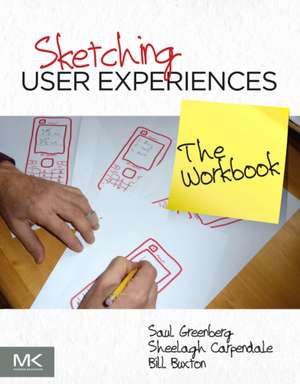Sketching User Experiences: The Workbook
Autor Saul Greenberg, Sheelagh Carpendale, Nicolai Marquardt, Bill Buxtonen Limba Engleză Paperback – 13 dec 2011
The book discusses the differences between the normal ways to sketch and sketching used by user-experience designers. It also describes some motivation on why a person should sketch and introduces the sketchbook. The book reviews the different sketching methods and the modules that contain a particular sketching method. It also explains how the sketching methods are used.
Readers who are interested in learning, understanding, practicing, and teaching experience design, information design, interface design, and information architecture will find this book relevant.
- Features standalone modules detailing methods and exercises for practitioners who want to learn and develop their sketching skills
- Extremely practical, with illustrated examples detailing all steps on how to do a method
- Excellent for individual learning, for classrooms, and for a team that wants to develop a culture of design practice
- Perfect complement to Buxton’s Sketching User Experience or any UX text
- Author-maintained
companion
website
at
http://grouplab.cpsc.ucalgary.ca/sketchbook/
Preț: 111.42 lei
Preț vechi: 122.99 lei
-9% Nou
21.32€ • 22.36$ • 17.75£
Disponibilitate incertă
Specificații
ISBN-10: 0123819598
Pagini: 272
Dimensiuni: 216 x 276 x 23 mm
Greutate: 0.89 kg
Editura: Elsevier
Public țintă
Students, professors, and professionals from multiple disciplines; Computer Science, Industrial Design, Digital Media Design, Cognitive Science, Fine Art etc.; User experience community (Information Architects, Interface Designers, Interaction Designers, Usability engineers, etc.); Computer Scientist specializing in HCI and/or Information Visualization; Arts and Industrial Design community (Graphic Designers, Web Designers, Information Designers, Product Designers, Industrial Designers); Product Managers, Creative Directors, etc.Cuprins
1 GETTING INTO THE MOOD
2 SAMPLING THE REAL WORLD
3 THE SINGLE IMAGE
4 SNAPSHOTS OF TIME: THE VISUAL NARRATIVE
5 ANIMATING THE USER EXPERIENCE
6 INVOLVING OTHERS
Recenzii
Descriere
Sketching Working Experience: The Workbook provides information about the step-by-step process of the different sketching techniques. It offers methods called design thinking, as a way to think as a user, and sketching, a way to think as a designer. User-experience designers are designers who sketch based on their actions, interactions, and experiences.
The book discusses the differences between the normal ways to sketch and sketching used by user-experience designers. It also describes some motivation on why a person should sketch and introduces the sketchbook. The book reviews the different sketching methods and the modules that contain a particular sketching method. It also explains how the sketching methods are used.
Readers who are interested in learning, understanding, practicing, and teaching experience design, information design, interface design, and information architecture will find this book relevant.
- Features standalone modules detailing methods and exercises for practitioners who want to learn and develop their sketching skills
- Extremely practical, with illustrated examples detailing all steps on how to do a method
- Excellent for individual learning, for classrooms, and for a team that wants to develop a culture of design practice
- Perfect complement to Buxton’s Sketching User Experience or any UX text
- Author-maintained companion website at http://grouplab.cpsc.ucalgary.ca/sketchbook/
